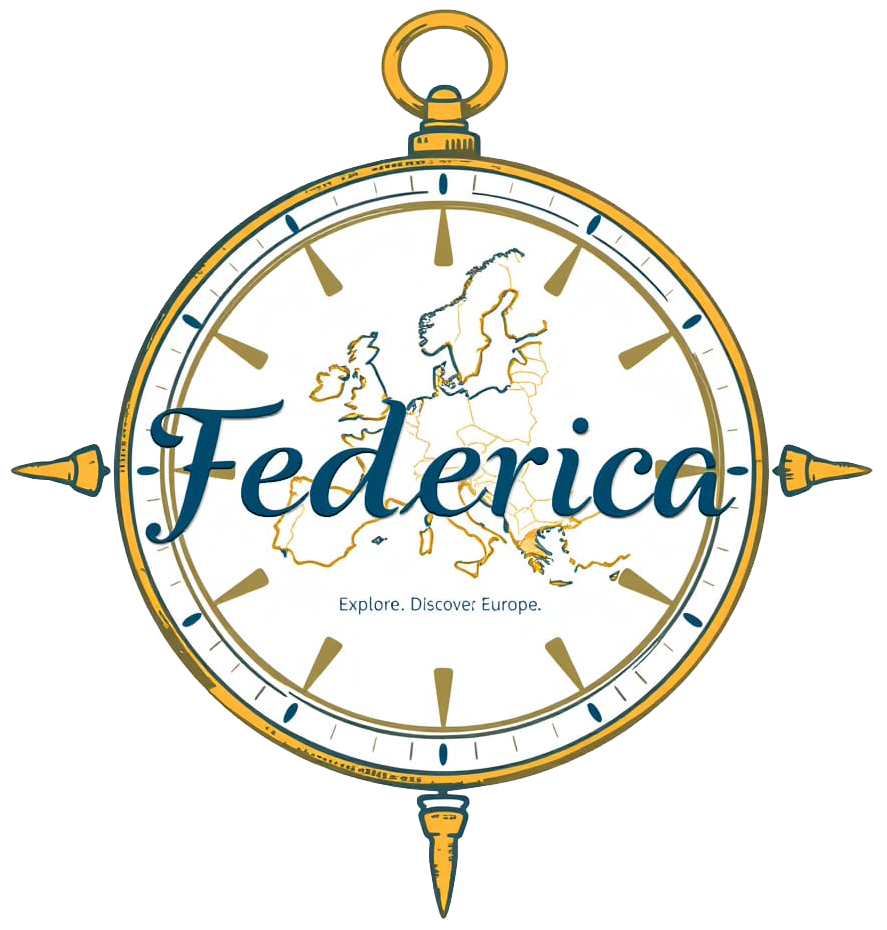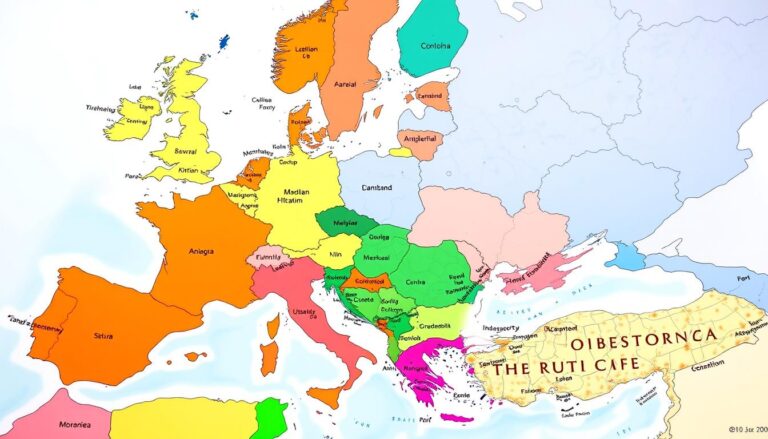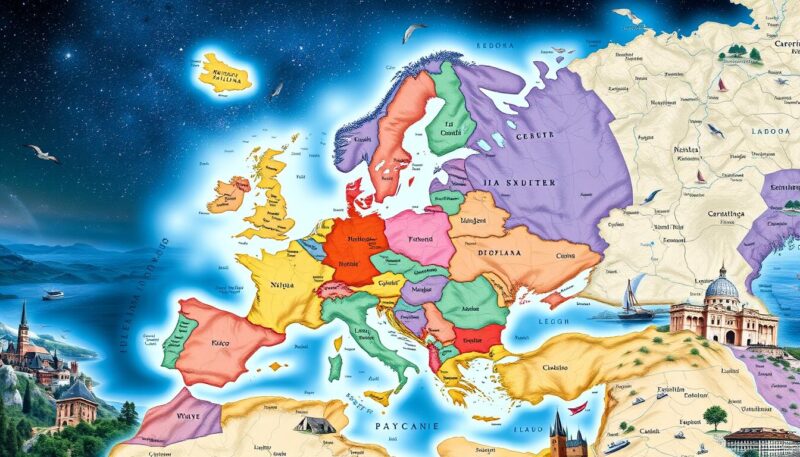Europe, often referred to as “the Old Continent,” is a land steeped in history, culture, and political significance. Covering approximately 10.18 million km², it’s the second-smallest continent by surface area. However, its influence far exceeds its geographical size. The political geography of Europe is complex, with around fifty sovereign states defining its borders. Understanding how many countries are in Europe involves not just counting these states, but also delving into their unique attributes and historical evolution.
Located entirely in the Northern Hemisphere and mostly in the Eastern Hemisphere, Europe is bordered by the Arctic Ocean to the north, the Atlantic Ocean to the west, the Mediterranean Sea to the south, and Asia to the east. This geographical positioning has fostered a diversity of climates, landscapes, and cultures that have shaped the continent’s political and social narratives. The myriad of languages spoken, the variety of religions practised, and the differing political systems all contribute to the rich tapestry that is Europe’s identity.
Historically, Europe has been the battleground for numerous conflicts and the cradle of significant cultural and intellectual movements. From the fall of the Western Roman Empire to the Renaissance, and from the Age of Enlightenment to the Industrial Revolution, Europe’s historical events have left indelible marks on its political boundaries. The continent’s demographic landscape reflects these historical influences, with a population of approximately 745 million people as of 2021, representing about 10% of the world’s population.
In contemporary times, the European Union (EU) plays a crucial role in the continent’s political dynamics. Established to foster economic cooperation and prevent future conflicts, the EU has grown to become a formidable economic and political entity. It represents the majority of Europe and is the third-largest economy globally. The integration of European countries into the EU has significantly reshaped the political map of Europe, promoting a more unified and cooperative environment.
However, the complexity of European borders extends beyond the EU. The Schengen Area, for instance, allows for passport-free travel between member countries, further blurring traditional boundaries. There are 27 countries in the EU, 20 of which use the euro as their currency. The continent also hosts several microstates, such as the Vatican City, the smallest country by both land area and population.
The political geography of Europe is a testament to its rich history and dynamic future. By exploring how many countries are in Europe and understanding the intricacies of their borders, you gain a deeper appreciation for the continent’s unique place in the world. The next sections will delve into the specifics of these political boundaries and the countries that form this diverse and influential continent.
Introduction to European Political Boundaries
Understanding The Definition of Europe: Geographical and Political Scope requires a closer examination of historical and contemporary influences. Europe’s geographical boundaries are defined by significant landmarks such as the Ural Mountains, the Ural River, and the Caspian Sea to the east, setting a clear demarcation line from Asia. These natural boundaries have been acknowledged since the mid-19th century, shaping the physical outline of the continent.
The political boundaries, however, have undergone numerous transformations throughout history. The Roman Empire, for instance, had a profound impact on European political systems, language, and law. The influence of the Roman Empire is still evident today in many of Europe’s political systems and state capitals.
Europe’s political landscape has witnessed dramatic shifts influenced by pivotal events such as the World Wars and the Cold War. Post-World War adjustments and the east-west divide during the Cold War further redefined Europe’s geographical and political scope.
Integration processes such as the formation of the European Union have notably re-shaped The Definition of Europe: Geographical and Political Scope, fostering political cooperation and creating new boundaries within the continent. The European Union now consists of 27 member states, with 19 using the euro as their official currency. Such integration efforts highlight the continent’s evolving political harmony.
Interestingly, the continent accommodates 50 sovereign states, with generally recognised boundaries. However, real-world complexities present unique cases such as Kosovo, which has limited but substantial international recognition. Moreover, there are eight entities in Europe with special political arrangements or are not integral parts of a European state.
To provide further clarity, here is a table illustrating various aspects of European political boundaries and recognitions:
| Aspect | Details |
|---|---|
| Total Recognised Sovereign States | 50 |
| Kosovo’s Recognition | Limited but substantial |
| Unrecognised de facto States | Four |
| Special Political Arrangements | Eight entities |
| European Union Members | 27 |
| Countries Using Euro | 19 |
| European Cultural Convention & Olympic Committees Members | 50 |
Understanding The Definition of Europe: Geographical and Political Scope through the lens of historical evolution and present-day realities offers you a comprehensive insight into the continent’s dynamic boundaries and political landscapes. From the physical geography that demarcates the boundaries to the complex political systems shaped by historical events, Europe presents a rich tableau of political and geographical diversity.
How Many Countries Are in Europe?
You may be surprised to learn that Europe is home to a diverse array of nations, each with its distinct identity, culture, and government system. This fascinating mix includes both Sovereign States and De Facto Countries. As of 2024, Europe comprises approximately 42 separate countries, with some regions like Kosovo and Northern Cyprus recognised as de facto countries due to partial international recognition.
When considering the political landscape, the European Union (EU) is a significant player, with 27 member countries forming a major part of the continent’s political fabric. These member states range from Malta, the smallest with a population of 542,051 people, to Germany, the largest in both population (84,358,845 individuals) and economic influence.
The EU’s influence extends beyond the borders of its member states, affecting both internal and external policies. The Union is an amalgamation encompassing various forms of government systems: 21 republics, 6 monarchies, 21 parliamentary representative democracies, 5 semi-presidential representative democracies, and 1 presidential representative democracy. Each state within the EU has its unique structure and governance, contributing to the complex yet harmonious fabric of the Union.
In addition to the Sovereign States and De Facto Countries within the EU, several European nations maintain economic and political independence from the Union. Countries like Norway and Switzerland have opted out of EU membership, retaining their distinct economic policies and regulatory frameworks, while still being key players in the broader European context.
| Country | Population (2024) | Land Area (km²) | Government Type |
|---|---|---|---|
| Germany | 84,358,845 | 357,022 | Parliamentary Republic |
| France | 65,398,000 | 638,475 | Semi-Presidential Republic |
| Malta | 542,051 | 316 | Parliamentary Republic |
| Norway | 5,502,000 | 385,207 | Constitutional Monarchy |
| Switzerland | 8,703,000 | 41,290 | Federal Republic |
To delve deeper into Europe’s complex matrix, it helps to segment the continent into geographical and cultural regions: Eastern Europe, Western Europe, Northern Europe, and Southern Europe. Each region vibrates with its unique history, traditions, and political landscapes, contributing to the rich tapestry that is Europe.
Conclusion
As we chart the political terrain of Europe in the 21st century, it becomes clear that the continent’s complexities are both its challenge and strength. The European Union, with its 27 member states covering over 4.2 million square kilometres and a population exceeding 449 million, stands as a testament to the power of European integration. This intricate tapestry of nations, languages, and cultures plays an undeniable role in shaping not only the present but also the future of Europe.
In recent years, the EU has demonstrated remarkable economic prowess, generating a nominal GDP of around $16.6 trillion in 2022 and $19.4 trillion in 2024, with a Gini index of 29.6 reflecting low inequality. Such economic indicators underscore the success of collective European efforts. Yet, the future is entwined with challenges as discussions on enlargement persist. With up to 35 countries considering EU membership, the potential for growth is vast, albeit accompanied by concerns regarding public opinion, regional funds, and farming impacts.
The departure of the United Kingdom in 2020 and ongoing negotiations with aspiring members highlight the EU’s dynamic nature. The bloc’s success hinges not only on maintaining its unity but also on evolving policies that accommodate new members without diluting the benefits enjoyed by existing ones. As you contemplate Europe’s journey, consider this: the future of Europe will undoubtedly be shaped by its ability to adapt, integrate, and face challenges collectively, preserving its unique cultural mosaic while striving for greater unity and prosperity.


